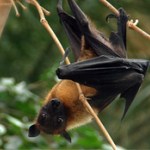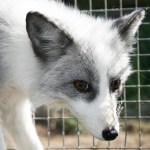fox
Image of Indian Flying Fox from Wikipedia, Fritz Geller-Grimm
An ambititous project seeks to identify all unknown viruses in mammals to determine the relative risk of infection to humans and to develop strategies to prevent and treat infections before they become pandemics. The pioneering research team is led by Dr. Simon Anthony at Columbia University and Dr. Peter Daszak from EcoHealth Alliance.
The team started by looking for viral infections in the Indian flying fox (Pteropus giganteus), a species with pathogens known to transfer to humans (Nipah and Hendra viruses). Over five…
Welcome to the third installment of Animal Territoriality Week. See part 1 here, and part 2 here.
In 1994, a disease called sarcoptic mange swept through Bristol's fox population, severely crippling the population and killing most of the individuals. Professor Stephen Harris of the University of Bristol, who had been studying the movements and territories of those foxes, noticed that as the animals in one territory died, neighboring foxes were able to colonize the vacant areas in 3-4 days. He suspected that this was because the scent marks of the foxes remained active for 3-4 days, but didn'…
There is a small bit of land, only about a square kilometer, that has added a new wrinkle to the story of animal domestication. This bit of land located in Northern Jordan, just southeast of the Sea of Galilee near the banks of the Jordan River, is home to an archaeological site known as 'Uyun al-Hammam. One key feature of this site, excavated in 2005, is a burial ground containing the remains of at least eleven humans in eight different gravesites. The early humans were buried here sometime during the pre-Natufian period, or around 16,500 years ago.
Layout of the 'Uyun al-Hammam site, and…
Eric M. Johnson and I spent about 45 minutes discussing "evolutionary psychology beyond sex" last night, which you can see today on Bloggingheads "Science Saturday."
Or just watch it here:
For today's dose of monday pet blogging, head on over to a piece that I wrote for Scientific American that went up today. I used the invitation as an opportunity to a dig a little deeper into the story of Belyaev and his domesticated silver foxes (I previously wrote about them, here and here)
I will be reposting some dog-related posts from the archives in the coming few weeks as I prepare for the course I'm teaching this semester on dog cognition. Please let me know if you find something inaccurate or unclear.
Domesticated dogs seem to have an uncanny ability to understand human communicative gestures (see here). If you point to something the dog zeroes in on the object or location you're pointing to (whether it's a toy, or food, or to get his in-need-of-a-bath butt off your damn bed and back onto his damn bed). Put another way, if your attention is on something, or if your…
Several weeks ago, BBC Earth contacted me to let me know about this awesome new website they were building: Life Is.
The website, created by Firefly Interactive and The Brooklyn Brothers, will showcase some of the best images, videos and stories that the BBC Earth Natural History Unit has accrued in over 50 years of expeditions.
From the recent Life to the ground-breaking Life on Earth, BBC Earth has been at the forefront of our desire to discover more about our planet. The site, Life Is, fully compliments this back catalogue of programming enabling the viewer to see the content as it was…
You can have a pet domesticated fox of your very own - from the Russian fox farm I've previously written about - for the low low price of just $5,950.
Figure 1: Isn't he cute? Click to embiggen.
Check it out.
According to the website,
Housing:
Foxes can live outside or inside.They need shade from excessive heat and rain. A bed or blanket is nice, but optional.
If the fox lives outside, the cage should have a bottom or the walls of the cage should be dug in deep enough so that the fox cannot dig a hole and escape.
Inside your house, they will snuggle on a bed like a cat.
During the…
A drop in the bucket - a massive pile of bison skulls about to be ground into fertilizer, photographed circa 1870. From Wikipedia.
From almost the very start, wolves were not welcome in Yellowstone. When the national park was established by the United States government in 1872 the bison population had crashed - a victim of westward expansion, the fur trade, and the desire to deprive native people of an animal important to their existence - leaving the area's wolves little recourse but to begin preying upon local livestock. This did nothing to help their reputation. Already seen as nature's…
I've decided I want to cover some recent research on social cognition in domesticated dogs. But first, we need some background. So here's a repost from the old blog.
Today I want to tell you about one of my most favorite studies, ever, of animals. Are you ready? It's a FIFTY YEAR LONG longitudinal study of captive silver foxes in Russia. Gather around, pour yourself a cup of your favorite beverage, get comfortable, and enjoy storytime.
In 1948, Soviet scientist Dmitri Belyaev lost his job at the Department of Fur Animal Breeding at the Central Research Laboratory of Fur Breeding in Moscow…
Let me tell you a little story. When I was born my parents had two cats. One was named Garfield. The other...well, I don't remember what the other one was called. Not long after I was born, and little Jason was coughing up furballs, the doctors informed the parents that their little bundle of skin and hair was allergic to cats. It was then that teams were picked and lines were drawn. It was me or the cats. Luckily, the parents decided to keep me, and lose the cats. Imagine how much it would have sucked if they decided to keep the cats and lose me. I imagine if my younger brother had actually…
Yellowstone National Park is an amazing place. I stayed there for three days longer than I had originally planned and I still was not ready to leave it. Even if I had spent another week there I still would not have seen all the natural wonders of the park, but fortunately the BBC recently sent film crews to Yellowstone to capture its natural history in every season. These vignettes were expertly strung together in the miniseries Yellowstone: Battle for Life, and embedded below is one of the scenes in which a fox tries to catch dinner in the middle of winter:
see more Lolcats and funny…
Personally I like this video for its production value.
Visit msnbc.com for Breaking News, World News, and News about the Economy
I have had this picture for a while just waiting for groundbreaking news about Bat-eared foxes. Well it never came but I can't just stare at the little guys any longer and not post them.
Photo credit Floridapfe of South Korea's Everland Zoo
They aren't babies and therefore not ZooBorn's fodder, but they are pretty ridiculous. Insects make up 80% of the Bat-eared fox diet. The other 20% comprises rainbows and Hello Kitty memorabilia.








